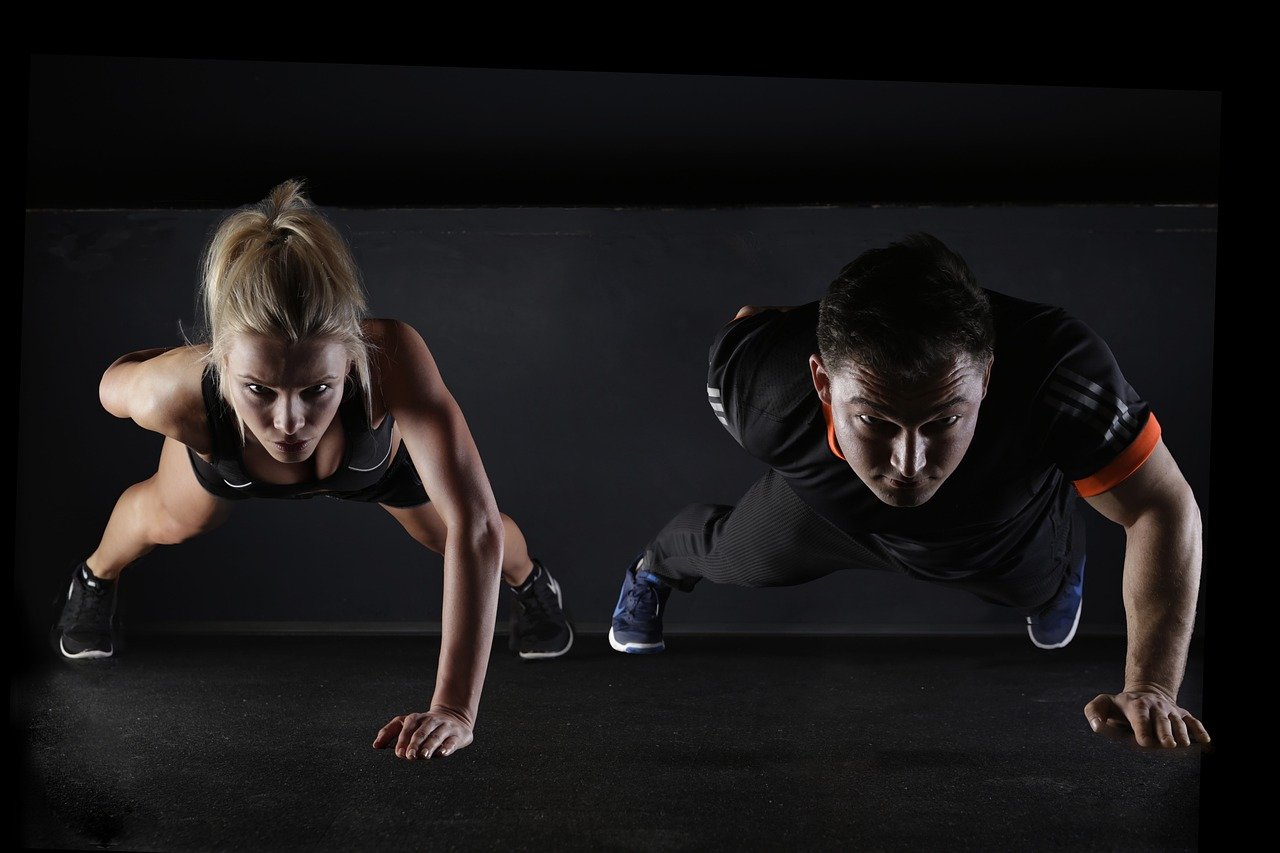The Ultimate Guide to Fitness and Health for Men and Women: Achieving Your Wellbeing Goals

Introduction to Fitness and Health
Fitness and health are integral components of a well-rounded lifestyle for both men and women. The importance of maintaining a balanced approach to physical activity, nutrition, and mental well-being cannot be overstated. Regular engagement in fitness activities plays a crucial role in enhancing one’s quality of life, promoting longevity, and reducing the risk of chronic diseases. It empowers individuals to lead healthier lives, boosting both physical and mental stamina.
Physical activity is a cornerstone of fitness, contributing not only to weight management but also to improved cardiovascular health, enhanced strength, and better flexibility. National health guidelines recommend consistent aerobic exercises, strength training, and flexibility workouts to maintain a healthy body. These activities work hand-in-hand with proper nutrition, which fuels the body by providing essential nutrients. A balanced diet rich in fruits, vegetables, lean proteins, and whole grains is vital for optimal health, allowing individuals to meet their fitness goals and preserve energy levels throughout the day.
Mental health is equally important in the context of overall wellness. Fitness routines can greatly reduce symptoms of stress, anxiety, and depression, creating a more balanced mental state. Activities like yoga and meditation, in combination with physical exercises, not only enhance the physical body but also foster emotional resilience and a sense of community among those leading similar wellness pursuits.
In essence, fitness should be a priority for both men and women as it contributes to improved health outcomes and a higher quality of life. Embracing a mindset that prioritizes fitness, coupled with a focus on nutrition and mental wellness, can lead to sustainable wellbeing. With a comprehensive approach, individuals can truly achieve their wellbeing goals and experience the profound impacts on their daily lives.
Different Fitness Goals: Men vs. Women
When it comes to fitness goals, men and women often pursue distinctly different objectives, shaped by a variety of factors including physiology, societal expectations, and personal aspirations. It is essential to acknowledge that while there are common goals, such as weight loss and improved endurance, the motivating factors behind these goals can differ significantly between genders.
- For many men, the focus traditionally leans toward muscle gain and strength enhancement.
- Men often aspire to increase their muscle mass and achieve a more muscular physique.
- This goalis frequently influenced by cultural standards emphasizing physical strength and muscle definition. As such, men might prioritize resistance training and higher protein intake within their nutritional regimens to facilitate this muscle growth.
- Enhanced strength can lead to improved performance in various physical activities, thereby reinforcing this goal.
Women, however, tend to place greater emphasis on overall health, aesthetic goals, and weight management. This often translates into a desire for weight loss or body toning rather than substantial muscle gain. Women are generally more inclined to pursue aerobic activities and strength training with lighter weights, focusing on toning rather than bulking up. Their health goals are frequently commingled with interests in wellness, flexibility, and cardiovascular endurance, aiming for a balanced approach to fitness that improves both physical appearance and overall vitality.
Despite these trends, it is crucial for both men and women to recognize the importance of personalized and realistic fitness goals. Each individual’s fitness journey should take into account their personal motivations, capabilities, and lifestyle. Setting attainable goals that align with one’s unique needs can foster a more enjoyable and effective fitness experience, ultimately leading to sustained success and improved wellbeing.
Nutrition Basics for Optimal Health
Nutrition plays a pivotal role in achieving optimal health and wellness for both men and women. Understanding the fundamentals of nutrition can significantly enhance one’s fitness journey. The primary components of nutrition are macronutrients and micronutrients, which serve distinct yet complementary functions in the body. Macronutrients, comprising carbohydrates, proteins, and fats, provide the energy necessary for daily activities and exercise. Carbohydrates should constitute a significant portion of the diet, as they are the body’s primary energy source, while proteins are essential for muscle repair and growth. Healthy fats, such as those found in avocados and nuts, are crucial for hormone production and cell health.
Micronutrients, which include vitamins and minerals, are also vital for maintaining overall health. These nutrients assist in various bodily functions, from immune support to energy production. Foods rich in micronutrients, like leafy greens, fruits, and whole grains, should be included in daily meals to ensure adequate intake. Furthermore, hydration is a fundamental aspect of nutrition often overlooked. Drinking sufficient water is essential for digestion, nutrient absorption, and overall bodily function. It is recommended for individuals to consume at least eight glasses of water daily, adjusting for activity levels and environmental conditions.
Portion control is another critical aspect of a balanced diet. It is essential to recognize serving sizes to avoid overeating and to maintain a healthy weight. Many people fall prey to dietary myths, such as the idea that carbohydrates should be entirely avoided or that consuming fats will lead to weight gain. In reality, a balanced diet that includes appropriate portions of all food groups will provide the necessary nutrients for energy and support fitness routines. By adhering to these nutritional guidelines and embracing balanced eating habits, individuals can enhance their overall wellbeing and performance in physical activities.
Creating a Customized Workout Plan
Designing a personalized workout plan is imperative for anyone looking to enhance their fitness levels and achieve health goals. The first step in creating an effective workout routine is to assess your current fitness level. Understanding your strengths and weaknesses will help you select appropriate exercises that cater to your individual needs. Whether your focus is on weight loss, muscle gain, or improved endurance, customizing your workouts to fit your specific objectives is essential.
There are several types of exercises to incorporate into your regimen, each offering unique benefits. Cardiovascular workouts, such as running, cycling, or swimming, play a vital role in improving heart health and enhancing overall endurance. Meanwhile, strength training, which includes bodyweight exercises or weight lifting, is crucial for building muscle and increasing metabolism. Flexibility exercises, such as yoga or Pilates, help maintain joint health and prevent injuries, while core workouts are fundamental for stability and balance. An effective workout plan typically includes a blend of these exercise types, ensuring a well-rounded approach to fitness.
Structuring your workouts efficiently is another key aspect of crafting a personalized routine. It is advisable to dedicate specific days for cardio, strength training, and flexibility. For example, consider a weekly schedule that allows for three days of strength training, two days of cardiovascular workouts, and regular flexibility sessions. Additionally, the incorporation of rest days is vital. Rest is when the body recovers and strengthens, making it an essential component of any workout plan. Tracking your progress will also help you stay motivated; consider keeping a fitness journal or using mobile apps to record your workouts, monitor improvements, and adjust your goals as needed.
In conclusion, creating a customized workout plan not only enhances the chances of achieving fitness and health goals but also allows individuals to engage in exercises they enjoy, leading to long-term commitment and success.
Essential Fitness Tips for Men
Embarking on a fitness journey requires understanding the unique physiological and psychological challenges men face. To effectively navigate this path, consider integrating the following essential tips into your routine. Building muscle is often a primary goal for many men. A tailored strength-training program that emphasizes compound movements, such as squats, deadlifts, and bench presses, can promote muscle gain and increase metabolism. Aim to incorporate these exercises at least three times per week, allowing sufficient recovery time for optimal growth.
Another critical aspect is the management of testosterone levels, which naturally decline with age but can be influenced by lifestyle choices. Regular strength training, quality sleep, and a balanced diet rich in healthy fats can help support hormonal balance. Foods such as avocados, nuts, and lean proteins should be staples in a man’s diet. Additionally, consider consulting with a healthcare professional if hormonal imbalances are a concern, as they can provide tailored advice and possible interventions.
Developing an effective workout routine is also vital. Men often face the challenge of monotony or losing motivation. To combat this, vary your workouts by trying new activities, such as swimming, cycling, or group fitness classes. This not only enhances physical fitness but can also improve mental engagement. For individuals struggling with mental barriers, setting realistic and incremental goals can foster a greater sense of achievement. It is essential to recognize progress, whether it’s lifting heavier weights or increasing workout frequency, as this builds momentum.
Lastly, consider surrounding yourself with a community or workout partner. Engaging with others who share similar goals can provide support, accountability, and motivation. Each of these elements plays a significant role in sustaining a productive fitness journey and achieving overall wellbeing.
Essential Fitness Tips for Women
For women striving to improve their fitness, understanding the specific challenges and considerations unique to their bodies is crucial. One of the foundational aspects of a successful fitness regime is strength training. Contrary to common misconceptions, incorporating strength training into regular exercise routines does not result in a bulky appearance; rather, it supports muscle toning and increases metabolism. Women should aim to include a variety of strength exercises that target different muscle groups at least two to three times per week.
Additionally, body image can significantly impact motivation and commitment to fitness goals. It is essential for women to cultivate a positive body image, enabling them to view their bodies as tools for strength and capability rather than solely for aesthetic purposes. Celebrating small victories over numbers on a scale can lead to greater enjoyment in workouts and a healthier relationship with fitness.
Understanding the hormonal cycles that women experience is also vital in tailoring fitness routines. Hormonal fluctuations can affect energy levels and recovery times, making it important to adjust workout intensity and type according to these cycles. For example, many women find that they experience higher energy and motivation during the follicular phase, making it an ideal time for high-intensity workouts. Conversely, during the luteal phase, focusing on gentler exercises such as yoga or lighter cardio might be more beneficial.
Listening to one’s body is paramount. Taking the time to understand physical cues can aid in optimizing performance and preventing injury. Practicing mindfulness during workouts can help women become attuned to their bodies’ needs, whether that means pushing through discomfort or allowing time for rest and recovery. By following these essential fitness tips, women can create a balanced approach to health and fitness that prioritizes their unique needs while fostering long-term wellbeing.
Incorporating Mental Wellbeing into Fitness
The interconnection between mental health and physical fitness is increasingly recognized in the realm of overall wellbeing. Engaging in regular physical activity can boost mood, alleviate stress, and ultimately enhance mental resilience. This correlation suggests that to achieve comprehensive fitness goals, individuals should focus not only on their physical performance but also on cultivating their mental wellbeing.
One effective method for integrating mental health practices into fitness routines is through mindfulness. Mindfulness involves being present and fully engaged with the current moment, which can greatly improve one’s response to stress and anxiety. By incorporating mindfulness techniques, such as deep-breathing exercises or meditation before workouts, participants can create a mental space that fosters clarity and focus. This practice can enhance the enjoyment of physical activities and improve performance levels.
Stress reduction is another crucial component of mental wellbeing that can significantly impact fitness outcomes. Engaging in physical activities such as yoga or tai chi not only strengthens the body but also contributes to mental calmness. These practices encourage relaxation and allow individuals to process emotions in a constructive manner, promoting a healthier mindset. Additionally, regular cardio workouts can release endorphins, the body’s natural mood lifters, which can alleviate feelings of stress and enhance overall emotional stability.
Moreover, establishing a supportive fitness community can bolster mental health. Social engagement during exercise, whether through group classes or training with friends, fosters a sense of belonging and can uplift spirits. Positive social interactions during workouts encourage accountability and can enhance motivation, leading to sustained fitness endeavors. By consciously incorporating these practices into fitness routines, individuals can develop mental resilience and significantly uplift their overall wellbeing.
Adapting Fitness for Aging Individuals
As individuals age, their fitness and health needs evolve significantly due to physiological changes that affect metabolism, muscle mass, and overall physical capability. It is crucial for aging individuals to adapt their fitness regimes to accommodate these changes while ensuring they maintain an active lifestyle. A thoughtful approach to physical activity can help mitigate age-related health issues, promote mobility, and enhance quality of life.
Firstly, older adults often experience a natural decline in muscle mass, known as sarcopenia, which can lead to decreased strength and endurance. Therefore, incorporating strength training into a fitness plan is essential. Resistance exercises, such as lifting weights or engaging in bodyweight activities like push-ups, can help counteract muscle loss and improve functional ability. It is advisable for older adults to start with lighter weights and gradually increase resistance as their capability improves, prioritizing safety.
Additionally, flexibility and balance exercises are vital for aging individuals. Activities such as yoga or tai chi can enhance stability, reduce the risk of falls, and promote overall joint health. Flexibility exercises help maintain a greater range of motion, allowing for easier daily activities. Moreover, cardiovascular health is paramount; low-impact aerobic activities such as brisk walking, swimming, or cycling should be encouraged to maintain heart health and improve endurance.
Equally important is understanding changes in metabolism that occur with age. Older adults might not burn calories as efficiently, establishing the need for a balanced diet that supports their nutritional requirements and complements their fitness efforts. Individuals should consult healthcare professionals before embarking on a new fitness journey to ensure that the chosen exercises align with their health conditions. Tailoring fitness plans to meet the unique needs of aging individuals fosters an environment for sustainable health and well-being.
Conclusion: Embracing a Lifelong Fitness Journey
Throughout this comprehensive guide, we have explored the essential components of fitness and health for both men and women. From understanding the importance of balanced nutrition to the benefits of regular physical activity, it is clear that achieving one’s wellbeing goals involves a multifaceted approach. Adopting a holistic mindset towards fitness can lead to not just short-term gains but also long-lasting vitality and health.
The journey towards optimal wellness is not simply a phase; it is a lifelong commitment to making informed choices that enhance both physical and mental health. Establishing a consistent fitness routine tailored to individual needs and preferences is crucial. Additionally, educating oneself about nutrition and incorporating a variety of foods into the diet can significantly augment overall wellbeing. As we discussed, staying motivated is essential, and having clear, achievable goals can help maintain focus on personal progress.
Seeking community support, whether through fitness classes, online forums, or local clubs, fosters an environment that encourages persistence and accountability. The presence of like-minded individuals can provide motivation and encouragement, making the fitness journey less daunting and more enjoyable. Remember that it is perfectly acceptable to seek assistance from professionals such as trainers or nutritionists, as these individuals can offer personalized guidance tailored to specific needs.
In conclusion, embracing fitness as a lifelong journey rather than a temporary goal is fundamental for sustained health and wellbeing. By fostering a proactive attitude towards fitness and surrounding oneself with supportive networks, both men and women can achieve their wellness aspirations and lead enriching lives. It is through informed choices, community engagement, and unwavering dedication that enduring fitness becomes not just achievable, but a fulfilling way of life.






